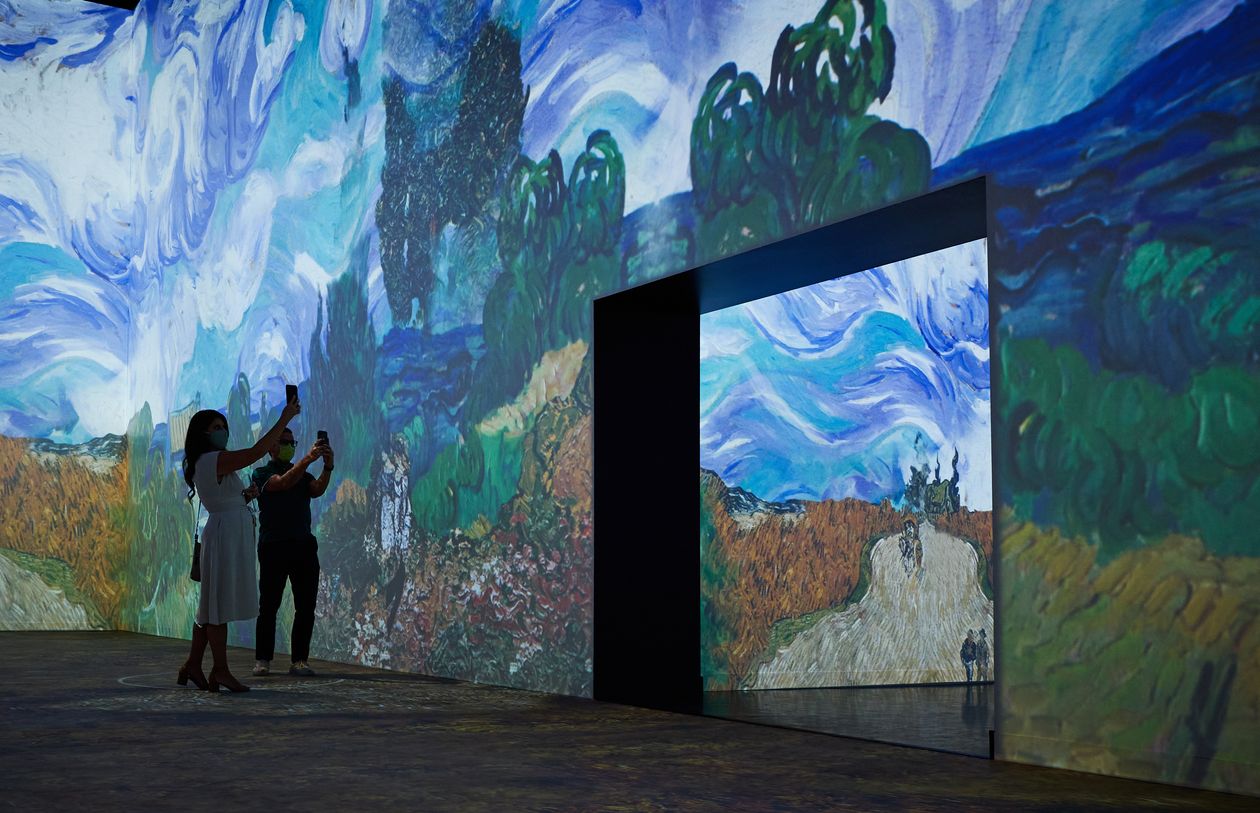Museum directors are looking warily over their shoulders at the recent proliferation of newer, immersive art productions. At least five production companies are circulating roughly 40 immersive versions of the life and art of Vincent Van Gogh around the U.S., sometimes doubling up in metropolitan areas like Dallas, which has two rival Van Gogh immersives running now.
The dilemma is that museums—even those offering free admission—are struggling to rebuild their audiences amid the pandemic, so it irks that multisensory art events are selling out shows even when tickets rival rock concerts, topping $100.
“These multisensory experiences are not art—they’re a form of entertainment,” said Max Hollein, director of New York’s Metropolitan Museum of Art, where attendance currently hovers around half the museum’s pre-pandemic levels. “We’re keeping an eye on these shows, but we don’t need to emulate them.”

In Dallas, art lovers have two options to watch immersive shows of the same artist. At this one, the ‘Immersive Van Gogh Exhibit,’ visitors can get a sunflower-covered cushion to sit on in rooms blanketed in arty imagery.
Photo: Jonathan Zizzo
In Texas, producers of “Van Gogh: The Immersive Experience” said their show has sold 100,000 tickets since October. Compare that to the nearby Dallas Museum of Art, where attendance for the entire year is only expected to cross 300,000 people—roughly a third of its pre-pandemic levels. Ironically, the Dallas museum is getting a slight bump in foot traffic thanks to its own Van Gogh exhibit of olive groves, the culmination of nine years of curatorial research.
Cindy Parrish, who works for a commodities-trading firm in Dallas, considers herself a Van Gogh fan. But instead of hitting up the museum, she recently paid $50 twice to see one of the Van Gogh immersives located at a ballpark in nearby Arlington.
“You walk in and go, ‘Oh wow!’” she said. “This is more than just walking up to a painting—you feel like you’re in one.”
“‘These multisensory experiences are not art—they’re a form of entertainment’”
Producers of immersive shows say that their popularity proves younger audiences want to be wowed by art at an engulfing scale, as seen in an episode of the popular Netflix show “Emily in Paris.” But the shake-up is spooking traditional museums that have long assumed that people would rather stand in front of an actual masterpiece than watch a projection of the same, no matter how big.

Mario Iacampo, producer of ‘Van Gogh: The Immersive Experience,’ says he peppers his shows with fun facts about the artists rather than aims for a scholarly approach.
Photo: Dan Swartz/Exhibition Hub & Fever

Texan Cindy Parrish recently paid $50 twice to go to a Dallas-area version of an immersive like this, saying, ‘This is more than just walking up to a painting—you feel like you’re in one.’
Photo: Dan Swartz/Exhibition Hub & Fever
At Ohio’s Columbus Museum of Art, where a major show about Van Gogh’s work opened last month, Executive Director Nannette Maciejunes said some visitors thought the “Immersive Van Gogh Exhibit” was opening inside the museum, rather than at a former furniture store. Billboards for the immersive show read, “It’s safe to Gogh.”
SHARE YOUR THOUGHTS
Did you attend a Van Gogh pop-up exhibit? What other artists would you be interested in seeing in this fashion? Join the conversation below.
“It was awkward,” Ms. Maciejunes said. “Everybody in Columbus is talking about Van Gogh right now, and they either mean us or them. But their experience is popular culture about art, and ours is an exhibition of art.”
Such high-low distinctions have long existed in cultural circles, but museums should start regarding immersive shows as works of art themselves rather than threats, said Vince Kadlubek, co-founder and director of Meow Wolf, a New Mexico-based art collective that started experimenting with immersive art spaces more than a decade ago. Meow Wolf interactive exhibits in Santa Fe, Las Vegas and Denver are on track to collectively get 1.5 million visitors this year, Mr. Kadlubek said.

An immersive show of Van Gogh opened right before the Columbus Museum of Art unveiled its own exhibit that includes 17 paintings by the artist, including 1888’s ‘Tarascon Stagecoach.’
Photo: Columbus Museum of Art
“If the general public likes a thing, it’s entertainment,” he said, “and that’s seen as a dirty word to people who cling to the idea that art needs an air of specialness or exclusivity.”
Mario Iacampo, producer and artistic director of Exhibition Hub team behind “Van Gogh: The Immersive Experience,” said he came to the task in 2017 with a background in producing the Canadian light show Cavalia, not art. He picked Van Gogh because he wanted an artist with universal appeal and a large oeuvre—Van Gogh created roughly 900 paintings—that translate easily over social media.
“‘As much as we respect museums, they’re a cold environment where you’re expected to know about art when you walk in’”
Mr. Iacampo said he centered his iteration’s story line around “fun facts” about the artist, such as the 700 letters Van Gogh wrote to his brother. He also created sunflower backdrops where people could easily pose for photos.

Bean bags, sweeping classical music and narrated quotes are fixtures of ‘Van Gogh: The Immersive Experience.’
Photo: Dan Swartz/Exhibition Hub & Fever
The formula works: During the past four years, Mr. Iacampo’s Van Gogh immersives have overall sold 3.5 million tickets in 13 countries, with plans to pop up in at least six additional U.S. cities soon. It costs about $1 million to create the initial design, he said, but far less to set it up in multiple cities, a business model akin to circuses or rock concerts.
“As much as we respect museums, they’re a cold environment where you’re expected to know about art when you walk in,” he said. “There’s no learning curve with us. You come in and you hear his story.”
In Columbus, the museum director Ms. Maciejunes decided to do some reconnaissance by attending her local Van Gogh immersive—and she wound up taking notes, not jabs. She particularly liked one giant primer on impasto, or his style of thickly layering paint, in greater detail than her museum ever has done. But she said digital projections don’t advance any lasting scholarship on artists and minimize the heavy lifting curators often do.

Curators at the Dallas Museum of Art spent nine years researching and wrangling art loans to show 10 examples Van Gogh’s olive-grove paintings together for the first time.
Photo: Dallas Museum of Art
It took Nicole Myers, senior curator of European art at the Dallas museum, nine years and a team of 20 researchers and conservators to reorder the 15 olive-grove paintings Van Gogh painted in 1889. The resulting show represents the first time 10 of the examples have been publicly shown together.
To create an intimate setting, Ms. Myers arranged several works in an oval gallery painted deep purple. Unlike the other Van Gogh shows in town, there is no music blaring or bean bags piled on the floor. “We wanted to pull you in so that you feel like you’re surrounded by an olive grove,” Ms. Myers said. “I hate to call it immersive, but we were going for something different.”
Write to Kelly Crow at [email protected]
Copyright ©2021 Dow Jones & Company, Inc. All Rights Reserved. 87990cbe856818d5eddac44c7b1cdeb8








